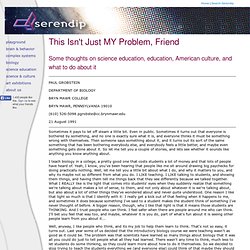

Grobstein, not just MY problem. (610) 526-5098 pgrobste@cc.brynmawr.edu 21 August 1991 Sometimes it pays to let off steam a little bit.

Even in public. Sometimes it turns out that everyone is bothered by something, and no one is exactly sure what it is, and everyone thinks it must be something wrong with themselves. Then someone says something about it, and it turns out its sort of the same something that has been bothering everybody else, and everybody feels a little better, and maybe even something gets done about it. I teach biology in a college, a pretty good one that costs students a lot of money and that lots of people have heard of.
Well, anyway, I like people who think, and its my job to help them learn to think. So we tried it out, and you can probably guess what our biggest problem was. What's funny about the whole thing is that lots of people know about the problem, and lots of people complain about it, and practically nobody does anything about it, and by not doing anything about it they make it worse. Ken Robinson says schools kill creativity. Why the United States Is Destroying Its Education System - Chris Hedges' Columns.
Why the United States Is Destroying Its Education System Posted on Apr 11, 2011 By Chris Hedges A nation that destroys its systems of education, degrades its public information, guts its public libraries and turns its airwaves into vehicles for cheap, mindless amusement becomes deaf, dumb and blind.

It prizes test scores above critical thinking and literacy. It celebrates rote vocational training and the singular, amoral skill of making money. Teachers, their unions under attack, are becoming as replaceable as minimum-wage employees at Burger King. Passing bubble tests celebrates and rewards a peculiar form of analytical intelligence. Teachers, under assault from every direction, are fleeing the profession. Get truth delivered to your inbox every week. Previous item: The End of Shutdowns Next item: Demanding the Impossible New and Improved Comments If you have trouble leaving a comment, review this help page. Top 200 - The Times Higher Education World University Rankings 2010-2011. U.S. falls in global ranking of young adults who finish college. Instead of gaining ground, the United States has fallen from 12th to 16th in the share of adults age 25 to 34 holding degrees, according to the report from the Organization for Economic Cooperation and Development. It trails global leaders South Korea, Canada and Japan and is mired in the middle of the pack among developed nations.
The stagnant U.S. performance on this key international benchmark reflects at least two trends: the rapid expansion of college attendance in Asia and Europe, and the continuing emphasis on four-year degrees in the United States while other nations focus far more on one- and two-year professional credentials. “Most of these countries are moving ahead,” said Jamie Merisotis, chief executive of the Lumina Foundation, an advocate of higher education reform.
“And we are stuck in neutral.” Obama’s pledge challenged a society generally presumed to have the world’s best higher education system. “I think our country just got complacent. Highlights From PISA 2009: Performance of U.S. 15-Year-Old Students in Reading, Mathematics, and Science Literacy in an International Context. This report provides international comparisons of average performance in reading literacy and three reading literacy subscales and in mathematics literacy and science literacy. It includes the percentages of students reaching PISA proficiency levels, for the United States and the OECD countries on average, and trends in U.S. performance over time. It also reports average scores by gender for the United States and other countries and by student race/ethnicity and school socioeconomic contexts within the United States.
Supplemental tables on the NCES website include additional data from PISA 2009, including the percentages of students in all PISA countries reaching the PISA proficiency levels and information on trends in performance around the world in reading, mathematics, and science literacy. After the initial release of the NCES PISA 2009 U.S. national report and supplemental tables, some minor changes were made to the report text and to the supplemental tables.